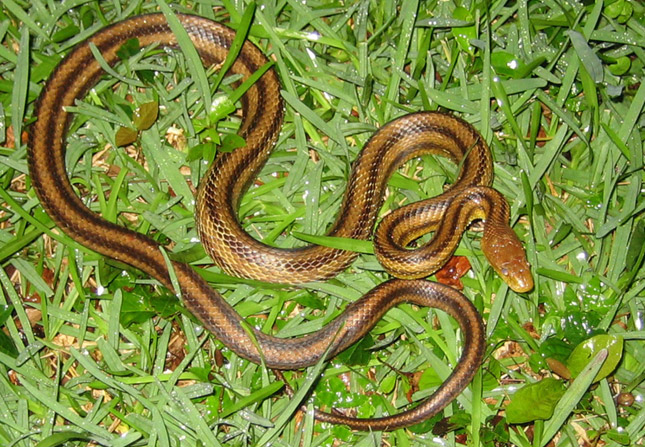
Biology:
Rat snakes are large constrictors that are mainly found in the northern hemisphere. Rat snakes are one of the largest kinds of species of snakes, with over 50 types of sub-species. One of the more common kinds of sub-species is the yellow rate snake. The yellow rate snake can reach up to ten feet but, in general, will grow as big as five to seven feet. These snakes are nonvenomous; however, there have been cases where some yellow rates snakes have been found to contain small doses of venom. Yellow rate snakes are usually very greenish with tints of both yellow and orange. Four dark stripes run along the length of its body. These stripes change with the region a yellow rate snake is from. Central area rat snakes have olive-brown stripes; northern species have poorly defined and dark stripes; and, finally, yellow rat snakes from the south have stripes that are much narrower and lighter in color.
Baby yellow rat snakes look much different than the adult snake. For instance, the color in stripes doesn’t vary as much as it does in adult snakes. In general, all baby yellow rat snakes have four dark stripes that are usually much darker than the adult version.
Habitat:
The rat snake species exists throughout the northern hemisphere but is most common in regions within the United States. Yellow rat snakes are mostly found along the coastal areas of the United States, as well as some regions in Europe. The most populated area of yellow rat snakes is in southern Georgia and along the Savannah River in Carolina. Habitats include timbered hills, thick forests, floodplains and swamps. In suburban areas yellow rat snakes are found in abandoned buildings, farmhouses and smaller homes.
Yellow rat snakes like water and are very good swimmers. Because of this most rat snakes are found near water – which explains why the majority are found along the coast in the United States. When not out hunting, yellow rat snakes like to hang high in cypress oak trees.
Behavior:
Yellow rat snakes are primarily active at dusk and at night – although they sometimes will hunt during the day depending on their location. The behavior and habits of yellow rat snakes depends on the region they originate from. For example, rat snakes from more northern regions tend to be less aggressive than rat snakes from the south. The reasons for this remain unknown but scientists believe it may because of a difference in diets.
Baby yellow rat snakes are more prone to bite in defense than adult snakes; furthermore, wild species are much more defensive than captive-bred snakes. In general, yellow rat snakes will almost always be more aggressive during feeding time.
One of the more obvious ‘tells’ of a yellow rat snake is its defensive posture known as the ‘kink’. When freighted, or when sleeping, a yellow rat snake will move into a curved position. This position is supposed to depict them as a fallen branch and is used to fend off humans as well as other predators.
Diet:
As the name indicates, the most common food in a yellow rat snakes diet is rats. Other common types of food eaten by rat snakes include rodents, such as mice and chicks, as well as other types of smaller birds. Younger rat snakes prefer tree frogs and lizards as their first several meals.
The diet of a yellow rat snake is so wide ranged because they have an aptitude to be able to swallow very large prey. In the wild, rat snakes will primarily eat mice, rats, squirrels and bird eggs.
Reproductive:
Since the diet of a yellow rat snake has such variety, the life expectancy of the snake is quite large in comparison to other snakes. Furthermore, baby rat snakes have a completely different diet than adult snakes. This different diet removes the competitiveness with the snakes and therefore adult snakes are less likely to eat their young –something which is common in many species of snakes.
Yellow rat snakes will breed at least once a year. When this happens the snakes become much more aggressive. Although nonvenomous, it may be best to avoid yellow rat snakes during the spring months (the time of the year when the yellow rat snake is most likely to breed).
Many people want to know how to kill a Yellow Rat Snake, but you don't need to. The
best way to get rid of Yellow Rat Snakes is to simply leave them alone. You can also
use a Yellow Rat Snake trap to catch them - that's one of the best ways for how to
remove Yellow Rat Snake. For more information, go to my
Snake Removal - How to Get Rid of Snakes home page.
If you need Yellow Rat Snake removal in your city, click our Hire a Pro page.